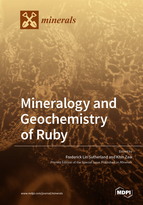Mineralogy and Geochemistry of Ruby
A special issue of Minerals (ISSN 2075-163X). This special issue belongs to the section "Mineral Geochemistry and Geochronology".
Deadline for manuscript submissions: closed (20 March 2020) | Viewed by 68881
Special Issue Editors
Interests: gem minerals; igneous petrology; volcanism; Australian geology; tectonics; mass extinction;
Special Issues, Collections and Topics in MDPI journals
Special Issue Information
Dear Colleagues,
Ruby, red corundum, is a gem mineral with mineral properties, gem characteristics and chemistry that are reliant on critical trace element substitutions in its aluminum oxide crystal structure. Ruby has attracted scientific and economic interest. It has already been studied extensively regarding its widespread global distribution and the diversity of its geological associations, as revealed by exploration and exploitation. Researchers are becoming increasingly aware that geographic typing of ruby characteristics and its host assemblages may guide further exploration and provide checks on reputed sources of both rough and cut stones. Genetic pointers, based on fluid and solid mineral inclusions, oxygen and other isotope values and pressure and temperature estimates, have already yielded much genetic information. Rare ruby in mantle xenoliths, TP ~1100o C, 2GPa, epitaxial diamond in ruby and ruby in diamond have special interest. Amid the present extensive documentation on this singular gem mineral, new insights and co-existing associations remain to be discovered. Although ruby largely appears in metamorphic and metasomatic source rocks, newer studies suggest it may also arise from magmatic sources. Age-dating of a range of mineral inclusions in ruby now allows more precise modelling of ruby genesis. Tectonic aspects of ruby genesis related to early collisional plate events on Earth are also a frontier for further understanding. In addition, ruby growth remains an important phase in metamorphic studies of events in some young collisional zones. This Special Issue planned for Minerals aims to attract further studies on this multi-origin gem mineral. Investigations at the ‘economic border’ of ruby and sapphire nomenclature and relevant treatments affecting ruby color will be considered.
Dr. Frederick Lin Sutherland
Prof. Dr. Khin Zaw
Guest Editors
Manuscript Submission Information
Manuscripts should be submitted online at www.mdpi.com by registering and logging in to this website. Once you are registered, click here to go to the submission form. Manuscripts can be submitted until the deadline. All submissions that pass pre-check are peer-reviewed. Accepted papers will be published continuously in the journal (as soon as accepted) and will be listed together on the special issue website. Research articles, review articles as well as short communications are invited. For planned papers, a title and short abstract (about 100 words) can be sent to the Editorial Office for announcement on this website.
Submitted manuscripts should not have been published previously, nor be under consideration for publication elsewhere (except conference proceedings papers). All manuscripts are thoroughly refereed through a single-blind peer-review process. A guide for authors and other relevant information for submission of manuscripts is available on the Instructions for Authors page. Minerals is an international peer-reviewed open access monthly journal published by MDPI.
Please visit the Instructions for Authors page before submitting a manuscript. The Article Processing Charge (APC) for publication in this open access journal is 2400 CHF (Swiss Francs). Submitted papers should be well formatted and use good English. Authors may use MDPI's English editing service prior to publication or during author revisions.
Keywords
- gem corundum
- ruby research
- trace elements
- spectroscopy
- O isotopes
- inclusions;
- P-T genesis
- metamorphic reactions
- gem deposits
- geographic typing







